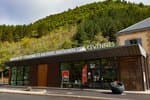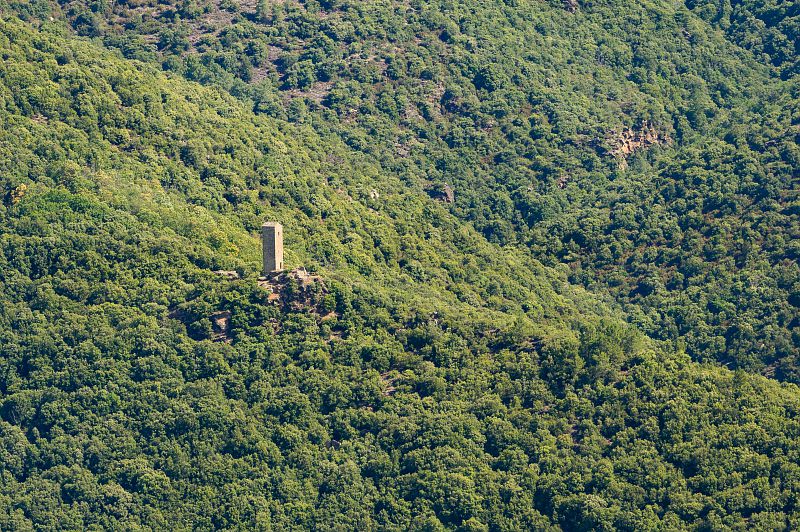
The Tour du Canourgue
Archaeological excavations carried out at the Tour du Canourgue have shown that it was the keep of a château, which was probably abandoned in the late 14th or early 15th century. A whole set of buildings once backed onto the keep outside the fortifications. Their ruins are today covered by vegetation. Mediaeval castra were built for both prestige and defensive purposes. Did Le Canourgue castrum ever have to defend itself? For two centuries, scholars have evoked the existence of a network of “signalling towers” designed to keep locals safe. Was that Le Canourgue's purpose?
10 points of interest
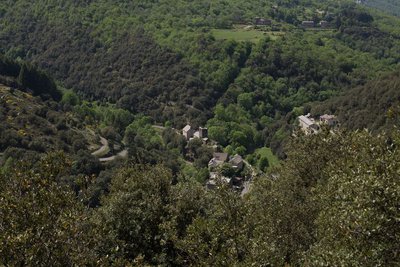
Vallée Française, temple de Molezon et tour de Biasses - © Sandrine Forge  Landscape
LandscapeThe scenery
From this vantage point you can discover the uppermost part of the Vallée Française, notably the temple (Protestant church) at Molezon and the tower of Biasses on the valley floor. In the west, the horizon is foreshortened by a limestone plateau: the Can de l’Hospitalet. This represents one of the furthest reaches of the ocean in the Mesozoic period, when it largely covered the old schist massif of the Cévennes.
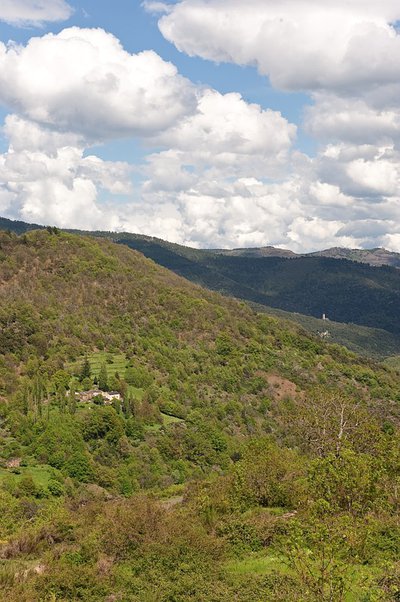
Paysage des Cévennes - © Guy Grégoire  History
HistoryThe Vallée Française
The Vallée Française, originally known as the Val Francesque, is the middle valley in a system of three parallel Cévenol valleys (incl. Vallée Longue to the north-east and Vallée Borgne to the south). Legend has it that under the command of Roland, one of Charlemagne’s valiant knights, the valley fought off the Saracen invasion and remained Frankish. Other hypotheses refer to a valley that was franche, meaning exempt from certain taxes. However, it is more likely that the Vallée Française was a Frankish foothold in Visigoth southern France (5th and 6th centuries) during the times of division that followed the fall of the Roman Empire under the pressure of the so-called “Barbarian” tribes.
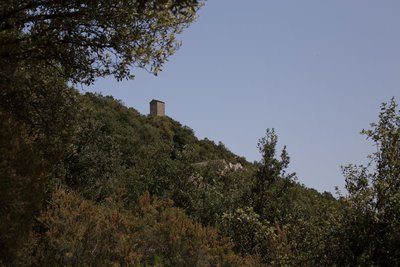
Tour du Canourgue - © Sandrine Forge  History
HistoryA glimpse of the Tour du Canourgue
Architectural deterioration caused by the wear and tear of time as much as by removal of stones almost vanquished this impressive monument, which has stood for centuries at the point of a rocky promontory. The conservation efforts of several Cévennes-loving volunteers kept the tower standing in the 1960s, but without saving it for good. The Cévennes National Park bought it in 1990 with the aim of turning it into one of the components of the Cévenne Eco-Museum, and fully restored it the following year. The holm oaks growing near this point partially hide a set of terraces that bear witness to farming in days gone by.
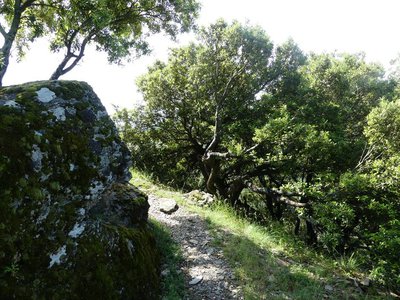
Montée dans les chênes verts - nathalie.thomas  Flora
FloraHolm oak or chestnut
As you walk uphill towards Le Canourgue Tower, you will see the distinct asymmetry between the two slopes and its effect on vegetation and farming. On the south-west slope, which is drier, rocky and steep, holm oak dominates. On the other side of the valley, the exposure to the north-east (and therefore lower temperatures) and the gentler gradient are accompanied by deeper soils, which favours chestnut trees.
 History
HistoryDating the site
The oldest records mentioning the Château du Canourgue date from 1219, but it is probably older. Throughout the 13th century, it was a fief of Raymond d’Anduze, then of Raymond de Barre. It then became a joint property of the King of France and the Bishop of Mende. Archaeological excavations have not been able to pinpoint exactly when it was built, but do show that it was abandoned in the late 14th or early 15th century, based on fragments of kitchenware discovered here (jugs and cooking pots from St-Quentin-la-Poterie, near Uzès).
 Architecture
ArchitectureAn oven
At the valley-end of the staircase was a partially overhanging building. On the ground, at a hollowed-out spot, is a sandstone millstone wedged into place on its base by small upright schist slabs. It was probably re-used as an oven floor, but research has not shown what kind of oven – for bread or other purposes.

 Architecture
ArchitectureDefending and asserting one's authority
There was a square building here that controlled access to the tower. Between the staircase and the entrance into the tower, staggered walls and a narrow corridor intersected by doors reinforced the keep’s defences. Its defensive capacity should not be over-estimated. Ten or so armed people could surely capture it. Though it was a fortification, above all it enabled the lords who owned it to project their authority symbolically. But this was also a residence of local seigneurs. Although there is no precise information about the Tour du Canourgue, by comparison with similar buildings one can estimate that 20 to 30 people lived in it.

 History
HistoryIncome from land and redevances
The lords of Le Canourgue had to live on the income from their lands, meaning the rents paid, especially in kind, by the peasants who farmed the estate's lands: sweet chestnuts or rye (grown underneath the chestnut trees), nuts and fruit (walnuts, plums, etc.), wine (not much) and meat products (essentially pork). Once a year, on a fixed date, the peasants living in the valley’s various mas or farms came to bring the rent they owed. Some farmed the terraced crop land near the castle and lived (among other professions) in the village built at its feet.

 History
HistoryThe signal-tower hypothesis
The Tour du Canourgue is sometimes described as a “signal tower” similar to the towers near the coast, which allowed locals to watch out for the “Barbary corsairs”, and to communicate using fire. Such a system would have required joint organisation and solidarity between the local lords. This was not exactly the most common scenario in the Cévennes from the 11th to the 14th centuries, when alliances, counter-alliances and conflicts followed one another. The Tour du Canourgue may have been used for sending signals – though no records have so far been found to support this theory – but that was patently not its primary function.

 Architecture
ArchitectureThe tower's architecture
On the facade, besides arrow-slits and one window, are two times two holes. This was probably where a wooden gallery (hoarding) was built on corbels to overhang the access.
Inside, on the first floor, the dimensions of the openings suggest that this was a living space despite its small size. On the top floor, the edge of the vault is embellished with a decorative cornice, an exact replica of the one in the keep at Garde-Guérin (north of Villefort). The double-sloped roof is the most common type for this kind of building. In the late 19th century (Romanticism), it was fashionable to add terraces and battlements when restoring towers.
Description
The trail passes through a grove of holm oaks before offering you several panoramic viewpoints over the Vallée Française. It then winds uphill through a ruined hamlet to the rocky spur on which stands the keep of Le Canourgue castrum (late 12th or early 13th century). After the defensive ditch, the path follows in the traces of disappeared buildings... Maps and illustrated scenes of mediaeval life have been reproduced inside the keep.
- Departure : On the D 983 road between Barre-des-Cévennes and Pont-Ravagers (Molezon)
- Arrival : On the D 983 road between Barre-des-Cévennes and Pont-Ravagers (Molezon)
- Towns crossed : Molezon
Forecast
Altimetric profile
Recommandations
Steep path with sections that are slippery when wet. Be sure to hold children by the hand.
Going all the way around the tower is dangerous. After Marker 10, it is advisable to retrace your steps to reach Marker 11.
Horse-riding or mountain-biking are not allowed on or adapted to discovery trails.
Information desks
Information center Le Pompidou
La poste, 48400 Le Pompidou
This centre is part of the National Park's associated tourist-information network, whose mission is to provide information on, and raise awareness of, the sites and events as well as the rules that must be observed in the National Park's central zone. :
Open year-round
Tourism'house and national Parc at Florac
Place de l'ancienne gare, N106, 48400 Florac-trois-rivières
This office is part of the National Park's associated tourist-information network, whose mission is to provide information on, and raise awareness of, the sites and events as well as the rules that must be observed in the National Park's central zone.
On site: exhibitions, video projections, events and shop Open year-round
Access and parking
On the D 993 between Pont-Ravagers et Barre-des-Cévennes
Parking :
Calculateur d'itinéraire Lio
Utilisez le calculateur liO pour organiser votre trajet en région Occitanie.
Autres régions
Calculez votre itinéraire en Auvergne Rhône Alpes sur Oùra
Biodiversité autour de l'itinéraire
Source

Report a problem or an error
If you have found an error on this page or if you have noticed any problems during your hike, please report them to us here:


